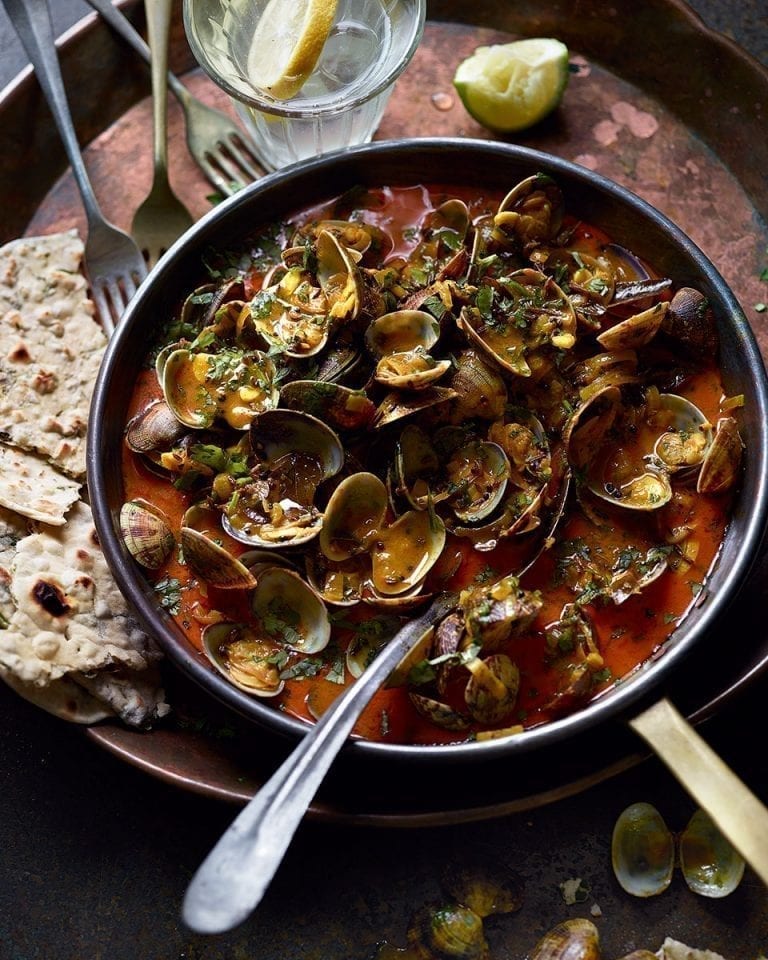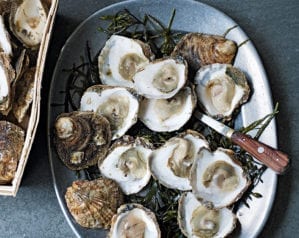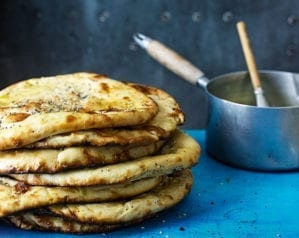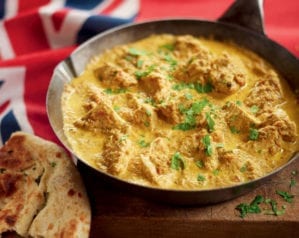
Keralan-style clams with herb-stuffed chapatis
- Published: 10 Feb 16
- Updated: 18 Mar 24
Herby chapatis pair perfectly with these mildly spiced, Keralan-style clams in this simple and impressive recipe.

Ingredients
For the curry
- 1.5kg clams (see Know-how)
- 2 tbsp vegetable or coconut oil
- 2 tsp fennel seeds
- 2 tsp black mustard seeds
- 2 tsp cumin seeds
- 6 garlic cloves, sliced
- Fat thumb-size piece fresh ginger, grated
- 3 banana shallots, sliced
- 30 fresh curry leaves, or 2g jar dried curry leaves (see tips)
- 1 tsp kashmiri chilli powder (or ½ tsp regular chilli powder)
- 1 tsp ground turmeric
- 400ml tin coconut milk
- 50ml tamarind water, made from
- 1 tbsp tamarind paste mixed with 35ml water
- 1 tsp soft brown sugar
- Juice 2-3 limes and chopped fresh coriander to serve
For the chapatis
- 250g plain flour, plus extra to dust
- ½ tsp fine salt
- 125ml water
- Large handful soft fresh herbs, chopped (coriander, mint, basil, chives or parsley all work)
Method
- Soak the clams in a sink full of well salted, iced water – it should taste like seawater when you lick your finger (see Know-how) – while you make the chapati dough.
- For the chapatis, put the flour and salt in a mixing bowl and stir in the water using a metal spoon. Once the dough starts to come together, use your hands to form it into a ball, then tip out onto a floured surface and knead for 4-5 minutes until smooth and elastic. Put back in the bowl and cover with a clean tea towel.
- For the curry, heat the vegetable or coconut oil in a large, lidded sauté pan or shallow casserole dish. Add the fennel, mustard and cumin seeds, garlic, ginger and shallots with a generous amount of salt. Cook over a medium heat, stirring often, until the shallots are starting to turn golden and everything is softened. Stir in the curry leaves, chilli powder and turmeric, then cook, stirring, for 3-4 minutes until everything is fragrant. If the spices start to catch, stir in a splash of water. Add the coconut milk, tamarind water and sugar, then bring to a gentle simmer and cook until the flavours are combined and mellow. Remove from the heat.
- Divide the chapati dough into 4 equal balls. Keeping the others covered with the tea towel, roll one ball out until 2mm thick. Put a quarter of the herb mix on half of the disc, spreading it right to the edges. Brush off the excess flour and fold the other half over, then into quarters. Gently roll out again, keeping the dough well floured, until 2mm thick again. Repeat with the remaining dough, covering the finished ones with a tea towel.
- Once you’ve shaped all the chapatis, heat a large frying pan over a high heat. When hot, put one of the chapatis into it and cook for a few minutes until golden on the underside, then flip and repeat. Transfer to a plate, cover with a tea towel, then repeat with the rest.
- Return the curry base to the heat and bring to a gentle simmer. Drain the clams, discarding any that don’t close when tapped firmly on the work surface (leave them a minute or two – some may be reluctant), and rinse briefly to remove the salty water. When the curry is bubbling, drop in the clams and cover tightly with the lid. Simmer gently, shaking the pan occasionally, for 4-5 minutes until the clams have all opened. If a couple remain tightly shut, discard them. Taste the sauce and add the lime juice to taste, then toss in the coriander leaves. Divide the curry among bowls and serve immediately with the chapatis.
- Recipe from January 2016 Issue
Nutrition
- Calories
- 606kcals
- Fat
- 27.6g (15.8g saturated)
- Protein
- 29.6g
- Carbohydrates
- 57.6g (7.6g sugars)
- Fibre
- 4.8g
- Salt
- 1.5g
delicious. tips
It’s worth seeking out fresh curry leaves – they’re not as fragrant when they’re dried. Kashmiri chilli powder is bright red and has a milder, more flavourful taste than regular chilli powder. Find it in speciality shops, or substitute with half the quantity of regular chilli powder.
Make the curry base up until the end of step 3, then chill in the fridge, covered, for 2-3 days. Bring to a simmer before adding the clams.
Soaking clams in salted water helps to remove any grit – they breathe the clean water, expelling the grit in the process. It’s really important it’s cold and very salty; otherwise you risk drowning the clams.
Buy ingredients online
Rate & review
Rate
Reviews
Subscribe to our magazine
Food stories, skills and tested recipes, straight to your door... Enjoy 5 issues for just £5 with our special introductory offer.
Subscribe
Unleash your inner chef
Looking for inspiration? Receive the latest recipes with our newsletter



